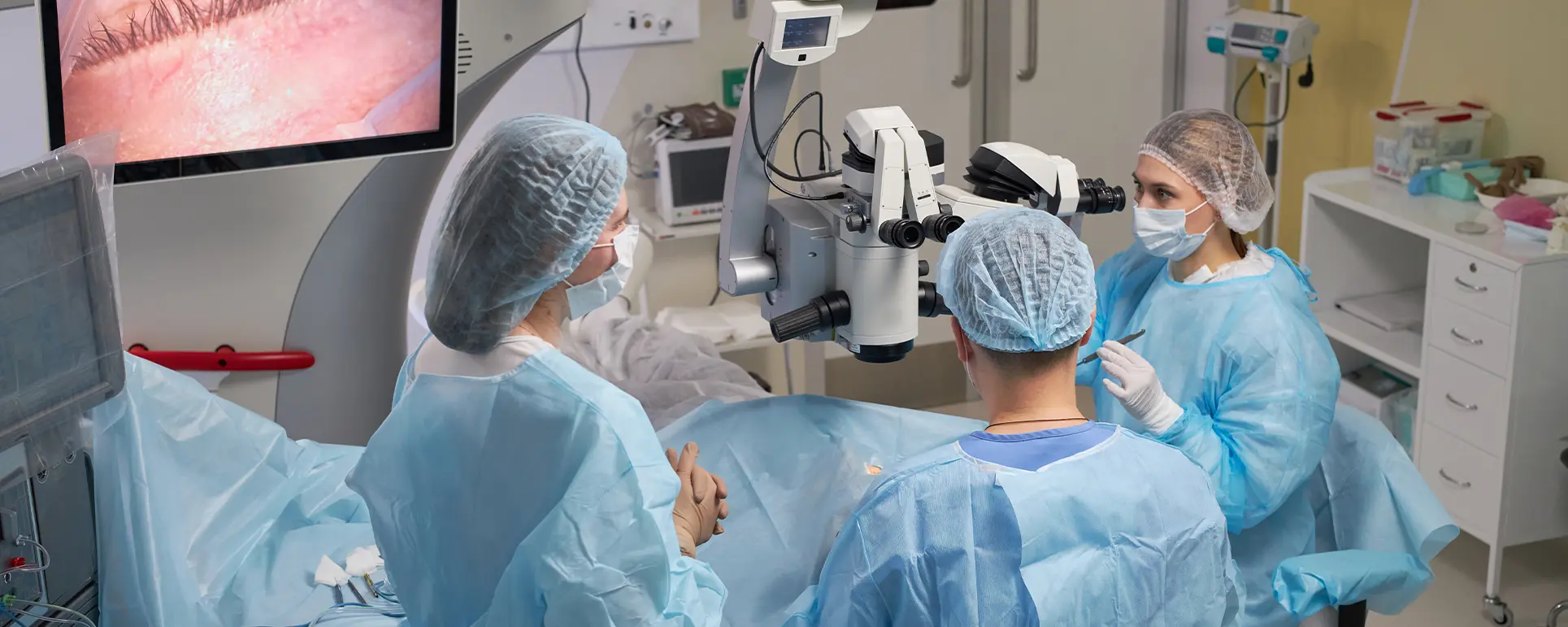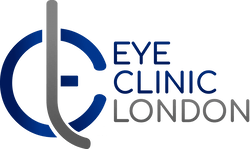Is PRK Eye Surgery Painful?

If you’re considering laser vision correction, you’ve probably come across PRK short for Photorefractive Keratectomy. It’s one of the most trusted procedures for improving eyesight, especially for people who may not qualify for LASIK.
But one question nearly every patient asks before surgery is: “Will PRK be painful?”
It’s a fair concern. While PRK has an excellent safety record and life-changing results, it’s true that recovery feels different compared to LASIK. There’s some discomfort involved but it’s manageable, temporary, and worth it for the long-term clarity you gain.
In this article, we’ll walk through exactly what PRK feels like during and after surgery, how it compares to LASIK, and what you can do to make your recovery as comfortable as possible.
What Is PRK Eye Surgery?
PRK (Photorefractive Keratectomy) is a type of laser eye surgery designed to correct common vision problems such as:
- Short-sightedness (myopia)
- Long-sightedness (hyperopia)
- Astigmatism
It reshapes the cornea the clear, front surface of your eye using an excimer laser, allowing light to focus correctly on the retina.
Unlike LASIK, PRK doesn’t involve creating a corneal flap. Instead, the thin outer layer of the cornea (called the epithelium) is gently removed before the laser reshaping. This makes it a great option for people with thin corneas or those who engage in contact sports, where flap-based procedures could pose risks.
Does PRK Hurt During the Surgery Itself?

Here’s the reassuring truth: PRK is not painful during the procedure.
Before your surgery begins, your ophthalmologist applies numbing eye drops to completely anaesthetise the surface of your eyes. You’ll remain awake but comfortable, and most patients describe the experience as feeling “odd but not painful.”
During the procedure, you might notice:
- A gentle pressure on your eye.
- Some cool air or light sensations.
- The sound of the laser clicking softly.
Each eye typically takes less than 10 minutes, and the laser part itself only lasts around 20–30 seconds.
So, while PRK may sound intimidating, the actual treatment is quick and virtually painless.
What Happens Right After Surgery?
Once the laser reshaping is complete, a bandage contact lens is placed on your eye. This acts as a protective layer while the epithelium naturally regenerates over the next few days.
You’ll rest for a short while before being allowed to go home. Most patients can see improvement in their vision even at this stage, though it may appear slightly hazy.
You might experience mild sensations such as:
- Light sensitivity.
- A gritty feeling, like there’s an eyelash in your eye.
- Slight watering or irritation.
These are normal and are managed easily with prescribed eye drops and pain relief medication.
Why PRK Recovery Feels Different from LASIK

Both PRK and LASIK reshape the cornea to correct your vision but they differ in how they access it.
LASIK involves creating a thin corneal flap, reshaping underneath, and repositioning the flap immediately. This allows for faster recovery and minimal discomfort.
PRK, on the other hand, removes the corneal surface cells, which must regrow naturally. This regeneration takes several days, which is why PRK recovery involves a slightly longer healing period.
That’s where most of the post-surgery sensations come from not the laser work itself, but the process of epithelial healing.
What Does PRK Feel Like in the Days After Surgery?
Everyone experiences PRK recovery a bit differently, but most describe mild to moderate discomfort in the first few days. Let’s break it down day by day:
Day 1:
Your eyes might feel gritty, watery, or sensitive to light. You may prefer to keep them closed and rest. Most people don’t feel pain more like mild irritation or dryness.
Days 2–3:
This is when discomfort can peak as the corneal surface begins to heal. It may feel like a burning or stinging sensation, similar to having sand in your eyes. Your doctor may recommend lubricating drops, cooling compresses, or prescribed pain medication to help.
Days 4–5:
The protective contact lens is usually removed once the epithelium has fully regenerated. At this point, your eyes feel much more comfortable, though vision may still be slightly blurry.
Weeks 1–2:
Your vision continues to stabilise. Light sensitivity fades, and you’ll likely be back to normal daily activities though you’ll still need to avoid rubbing your eyes or wearing makeup.
Most people say the discomfort is “annoying but manageable,” and it resolves entirely within the first week.
What Causes Discomfort After PRK?
The main source of discomfort after PRK is the healing of the corneal epithelium.
Once this layer is removed during surgery, nerve endings on the corneal surface are temporarily exposed. As the new cells regenerate, those nerves can become slightly irritated, creating sensations like dryness, stinging, or tearing.
Other common reasons for sensitivity include:
- Light sensitivity: As the eye adjusts during healing.
- Dryness: Reduced tear production temporarily after surgery.
- Inflammation: A natural part of the healing process.
Fortunately, your care team will provide everything you need from medicated drops to lubricants to manage these effects comfortably.
How Long Does PRK Pain Last?
For most patients, discomfort peaks around 48–72 hours after surgery and subsides significantly within five days.
By the end of the first week, most people report only mild dryness or light sensitivity. These minor symptoms continue to improve over the next few weeks.
It’s important to remember that PRK discomfort is temporary, while the visual improvement it provides is permanent.
Tips to Make PRK Recovery More Comfortable
Recovering from PRK doesn’t have to be unpleasant. Here are some proven ways to reduce sensitivity and promote faster healing:
- Use All Prescribed Eye Drops
Your ophthalmologist will give you antibiotic, anti-inflammatory, and lubricating drops. Follow the schedule carefully these prevent infection, reduce inflammation, and keep your eyes comfortable.
- Rest Your Eyes
Limit screen time for the first few days. Your eyes will heal faster if you give them regular breaks from bright lights and digital strain.
- Wear Sunglasses
Your eyes will be more sensitive to light immediately after surgery. Sunglasses not only help with comfort but also protect your healing corneas from UV rays.
- Avoid Rubbing Your Eyes
Even though they may feel itchy or watery, resist the urge to touch them. Rubbing can interfere with healing and increase the risk of infection.
- Use Artificial Tears Frequently
Keeping your eyes moist reduces irritation. Always choose preservative-free lubricating drops unless otherwise instructed.
- Sleep Well and Stay Hydrated
Good rest and hydration promote faster recovery and reduce dryness.
- Avoid Smoke and Dusty Environments
Irritants like smoke, dust, and strong wind can worsen dryness and discomfort. Try to stay in clean, humidified spaces when possible.
Comparing PRK and LASIK: Pain and Recovery
Both PRK and LASIK are virtually painless during surgery since you’ll receive numbing eye drops beforehand. The main differences come down to what you feel after the procedure and how quickly your vision clears.
With PRK, you might experience mild to moderate irritation for the first three to five days while the surface of your eye heals. Your vision will gradually sharpen over the next one to two weeks. This procedure is often a better choice if you have thinner corneas or play contact sports, as it doesn’t involve creating a corneal flap. You may feel some short-term discomfort, but once healed, the results are permanent.
With LASIK, recovery is usually quicker. You may notice only mild dryness or light sensitivity for a day or two, and your vision typically becomes clear within 24 to 48 hours. LASIK is ideal if you have thicker corneas and want faster results with minimal discomfort. Just like PRK, the results are long-lasting.
In short, both surgeries offer excellent outcomes. If you care more about safety and long-term stability, PRK might suit you better. But if you want to get back to your routine quickly, LASIK could be the more convenient option.
Is PRK Pain Worse Than LASIK?
Not necessarily it’s just different.
LASIK’s recovery is faster because the corneal surface isn’t fully removed. PRK’s discomfort comes from that surface layer healing, which naturally takes a few extra days.
Most patients who’ve had both procedures describe PRK discomfort as “like having sand in the eye” rather than true pain and they agree that the temporary irritation is well worth the long-term results.
How PRK Surgeons Minimise Discomfort
At Eye Clinic London, the surgical team takes several steps to ensure PRK recovery is as smooth as possible:
- Customised treatment plans: Based on your eye shape and sensitivity.
- Advanced laser technology: Creates smoother corneal surfaces for faster healing.
- Bandage contact lenses: Protect the eyes and reduce exposure-related irritation.
- Careful pain management: Including anti-inflammatory drops and optional oral pain relief if needed.
These measures mean that even though some sensitivity is expected, patients rarely describe the experience as painful.
What About Long-Term Sensitivity or Dryness?
Some people experience mild dryness or glare sensitivity in the weeks following PRK. This is temporary and improves as the nerves and tear glands stabilise.
Using lubricating drops regularly, especially during screen use or air-conditioned environments, helps immensely. If symptoms persist, your doctor may adjust your aftercare plan or recommend specialised tear supplements.
When to Contact Your Doctor
While mild irritation is normal, you should contact your clinic immediately if you experience:
- Sharp or worsening pain after the first few days.
- Significant swelling or discharge.
- Sudden loss of vision or increased blurriness.
- Persistent redness that doesn’t fade.
These could indicate an infection or complication that needs prompt medical attention.
Returning to Normal Life After PRK
Most patients return to work within a week, though this varies depending on your comfort and job type.
You’ll also need to:
- Avoid swimming or hot tubs for at least two weeks.
- Skip eye makeup for one week.
- Avoid contact sports or high-impact activities for 3–4 weeks.
By week two, your vision will be stable enough for most day-to-day tasks, and you’ll notice steady improvement in sharpness and contrast over the following months.
How to Mentally Prepare for PRK
A positive mindset makes a big difference. Knowing what to expect helps reduce anxiety and makes the process feel easier.
Remind yourself that:
- Discomfort is temporary.
- The results are long-lasting.
- You’ll be closely supported by your care team throughout recovery.
At Eye Clinic London, patients receive detailed pre- and post-surgery instructions and regular check-ups to ensure smooth healing and reassurance every step of the way.
Who Is the Ideal Candidate for PRK?
You may be a good candidate if you:
- Have thin corneas or irregular corneal shapes.
- Play contact sports or work in environments where eye trauma is possible.
- Want laser vision correction without corneal flap creation.
- Are over 18 with stable vision for at least one year.
Your ophthalmologist will perform a detailed eye assessment before confirming your suitability for PRK surgery in London.
Long-Term Comfort and Satisfaction
Once your eyes have fully healed, you’ll enjoy clear, natural vision without the hassle of glasses or contact lenses and without ongoing pain or sensitivity.
In fact, studies show PRK outcomes are just as good as LASIK in the long run, with high patient satisfaction and excellent visual results.
Many people choose PRK precisely because they value its safety and durability over short-term convenience.
Frequently Asked Questions About PRK Eye Surgery:
- Does PRK surgery hurt at all?
No, PRK surgery itself doesn’t hurt because your eyes are completely numbed with anaesthetic drops before the procedure starts. You’ll stay awake the whole time, but you won’t feel any pain just some light pressure or a cool sensation from the laser. The only mild discomfort tends to happen later, once the numbing wears off and your corneal surface starts to heal, which usually feels more like irritation or dryness rather than true pain. - How long does PRK recovery take?
Most people notice steady improvement in their vision within the first one to two weeks, but full recovery can take a few months as your eyes continue to fine-tune. In the first few days, your vision may feel a bit hazy, and your eyes can be sensitive to light. By the end of the first week, most of the irritation settles, and you can usually return to work or normal activities. However, your doctor will schedule follow-up visits to make sure healing is on track before you resume everything. - How is PRK different from LASIK in terms of pain and healing?
The main difference lies in how each procedure reshapes your cornea. LASIK creates a thin flap before laser correction, while PRK removes the surface layer completely, allowing it to regrow naturally. Because of that, PRK tends to cause a few days of mild discomfort while the epithelium heals. LASIK recovery is typically faster, with most patients seeing clearly within a day or two and experiencing little to no pain. Still, PRK is often preferred for people with thinner corneas or active lifestyles since it avoids flap-related risks. - When will my vision become clear after PRK?
You’ll start to notice some visual improvement within the first few days, but it can take up to two weeks for your vision to stabilise. Initially, your sight might seem blurry or hazy, especially when reading or using screens. Once your corneal surface has fully regenerated, your eyesight sharpens significantly. Over the next few months, clarity continues to improve until you reach your best-corrected vision which, for most patients, is 20/20 or very close to it. - How can I make my recovery more comfortable?
The best way to stay comfortable is to closely follow your aftercare plan. Use your prescribed eye drops exactly as directed, take breaks from screens, and wear sunglasses outdoors to protect your healing eyes from bright light. It’s also important to avoid rubbing your eyes or exposing them to smoke and dust. Staying well hydrated and getting plenty of rest also helps your eyes heal faster and feel less irritated. - Is there anything I shouldn’t do after PRK surgery?
Yes, there are a few temporary restrictions that help your eyes heal safely. You should avoid swimming, hot tubs, and saunas for at least two weeks, since these can increase the risk of infection. Eye makeup should also be avoided during the first week to prevent irritation. If you play contact sports or engage in physical activity where your eyes might get hit, it’s best to wait about three to four weeks or until your doctor confirms it’s safe. - Will I need glasses after PRK?
Most people don’t need glasses after PRK, especially if the surgery was done to correct nearsightedness, farsightedness, or astigmatism. However, if you’re over 40, you might still need reading glasses due to a natural age-related change called presbyopia, which affects near vision. Your surgeon can explain what to expect based on your age, prescription, and lifestyle needs. - Can both eyes be treated at the same time?
Yes, both eyes are often treated during the same appointment. Your surgeon will apply numbing drops to each eye, perform the procedure, and then place protective lenses to help with healing. Treating both eyes together means your recovery happens simultaneously, so you don’t have to go through the healing process twice. Some patients prefer treating one eye at a time, but most find same-day surgery more convenient and efficient. - Are there any long-term side effects of PRK?
Serious side effects are very rare, but it’s normal to experience temporary dryness, glare, or halos around lights during the first few weeks. These effects fade as your eyes adjust and fully heal. In the long term, PRK results are stable and permanent, meaning you can enjoy clear vision without ongoing pain or sensitivity. Following your aftercare instructions and attending your follow-up appointments greatly reduces any risk of complications. - How do I know if PRK is right for me?
You’re likely a good candidate if you have thin corneas, play sports where eye injuries are possible, or simply prefer a no-flap procedure. Your ophthalmologist will examine your eyes, measure your corneal thickness, and discuss your visual goals before recommending PRK. The decision ultimately depends on your eye health, prescription stability, and lifestyle. If you want a safe, long-term vision correction option without worrying about flap complications, PRK could be a perfect fit.
Final Thought: Feeling Confident About PRK
It’s natural to feel nervous about the idea of eye surgery, but PRK is not a painful procedure. Thanks to advanced numbing techniques and careful aftercare, discomfort is minimal and short-lived.
Most of what patients feel comes from the healing process a temporary stage that passes within a few days. The reward? Clear, lasting vision without glasses or contacts.
If you’re considering PRK surgery in London, you can contact us at Eye Clinic London. Our experienced team will provide a thorough assessment, personalised guidance, and support throughout the process, helping you achieve clear, confident vision safely.
References:
- Steigleman, W.A., 2023. ‘Management of Pain after Photorefractive Keratectomy’, American Journal of Ophthalmology, [online] 245, pp. 1–9. Available at: https://www.aaojournal.org/article/S0161-6420(22)00588-7/fulltext
- Zeng, Y., et al., 2015. ‘Application of a cold patch for relieving pain after trans-PRK’, Journal of Cataract & Refractive Surgery, [online] 41(11), pp. 2375–2380. Available at: https://pmc.ncbi.nlm.nih.gov/articles/PMC4532205/
- Pereira, V.B.P., et al., 2017. ‘Codeine Plus Acetaminophen for Pain After Photorefractive Keratectomy’, Journal of Refractive Surgery, [online] 33(9), pp. 591–597. Available at: https://pubmed.ncbi.nlm.nih.gov/28820793/
- Lichtinger, A., et al., 2011. ‘Gabapentin for postoperative pain after photorefractive keratectomy’, Journal of Cataract & Refractive Surgery, [online] 37(3), pp. 510–515. Available at: https://pubmed.ncbi.nlm.nih.gov/21366172/
- Betz, J., et al., 2023. ‘Ocular pain after refractive surgery: interim analysis of a prospective cohort study’, Ophthalmology, [online] 130(7), pp. 1101–1109. Available at: https://pmc.ncbi.nlm.nih.gov/articles/PMC10293021/

